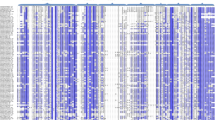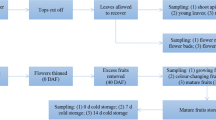Summary
A low molecular weight heat shock protein which localizes to chloroplasts has been identified in several plant species. This protein belongs to a eukaryotic superfamily of small HSPs, all of which contain a conserved carboxyl-terminal domain. To investigate further the structure of this HSP, we isolated and sequenced cDNA clones for the chloroplast LMW HSPs from Petunia hybrida and Arabidopsis thaliana. The cloning of chloroplast HSPs from these two species enabled us to compare the amino acid sequences of this protein from plant species (petunia, Arabidopsis, pea, soybean and maize) that represent evolutionarily divergent taxonomic subclasses. Three conserved regions were identified, which are designated as regions I, II and III. Regions I and II are also shared by cytoplasmic LMW HSPs and therefore are likely to have functional roles common to all eukaryotic LMW HSPs. In contrast, consensus region III is not found in other LMW HSPs. Secondary structure analysis predicts that this region forms an amphipathic α-helix with high conservation of methionine residues on the hydrophobic face and 100% conservation of residues on the hydrophilic face. This structure is similar to three helices, termed “methionine bristles”, which are found in a methionine-rich domain of a 54 kDa protein component of signal recognition particle (SRP54). The conservation of regions I and II among LMW cytoplasmic and chloroplast HSPs suggests that these HSPs perform related functions in different cellular compartments. However, identification of the methionine bristle domain suggests that chloroplast HSPs also have unique functions or substrates within the special environment of the chloroplast or other plastids.
Similar content being viewed by others
Abbreviations
- HS:
-
heat shock
- HSP:
-
heat shock protein
- LMW:
-
low molecular weight
References
Bernstein HD, Poritz MA, Strub K, Hoben PJ, Brenner S, Walter P (1989) Model for signal sequence recognition from amino-acid sequence of 54K subunit of signal recognition particle. Nature 340:482–486
Chen Q, Vierling E (1990) Structure and biochemistry of a low molecular weight chloroplast heat shock protein. J Cell Biochem 14E:296
Chen Q, Lauzon LM, DeRocher AE, Vierling E (1990) Accumulation, stability, and localization of a major chloroplast heat-shock protein. J Cell Biol 110:1873–1883
Cronquist A (1981) An integrated system of classification of flowering plants. Columbia University Press, New York
Delahodde A, Goguel V, Becam AM, Creusot F, Perea J, Banroques J, Jacq C (1989) Site specific DNA endonuclease and RNA maturase activities of two homologous intron-encoded proteins from yeast mitochondria. Cell 56:431–441
Demmin DS, Stockinger EJ, Chang YC, Walling LL (1989) Phylogenetic relationships between the chlorophyll a/b binding protein (Cab) multigene family: an intra- and interspecies study. J Mol Evol 9:266–279
Devereux J, Haeberli P, Smithies O (1984) A compressive set of sequence analysis programs for the VAX. Nucleic Acids Res 12:387–395
Feinberg AP, Vogelstein B (1983) A technique for radio-labeling DNA to high specific activity. Anal Biochem 132:36–38
Grimm B, Ish-shalom D, Even D, Glaczinski H, Ottersbach P (1989) The nuclear-encoded 22-kDa heat-shock protein of Chlamydomonas. Eur J Biochem 182:539–546
Helm KW, Vierling E (1989) An Arabidopsis thaliana cDNA clone encoding a low molecular weight heat shock protein. Nucleic Acids Res 17:7995
Higgins DG, Sharp PM (1988) CLUSTAL: A package for performing multiple sequence alignments on a microcomputer. Gene 73:237–244
Ingolia TD, Craig EA (1982) Four small Drosophila heat shock proteins are related to each other and to mammalian α-crystallin. Proc Natl Acad Sci USA 79:2360–2364
Keegstra K, Olsen LJ (1989) Chloroplastic precursors and their transport across the envelope membranes. Ann Rev Plant Physiol Plant Mol Biol 40:471–501
Kimpel JA, Key JL (1985) Heat shock in plants. Trends Biochem Sci 10:353–357
Kloppstech KG, Meyer G, Schuster G, Ohad I (1985) Synthesis, transport and localization of a nuclear coded 22-kd heat shock protein in the chloroplast membranes of peas and Chlamydomonas reinhardi. EMBO J 4:1901–1909
Laemmli UK (1970) Cleavage of structural proteins during the assembly of the head of bacteriophage T4. Nature 227:680–685
Lindquist SL, Craig E (1988) The heat shock proteins. Annu Rev Genet 22:631–677
Nieto-Sotolo J, Vierling E, Ho T-H D (1990) Cloning, sequence analysis and expression of a cDNA encoding a plastid localized heat shock protein in maize. Plant Physiol 93:1321–1328
Nover L, Scharf KD, Neumann D (1989) Cytoplasmic heat shock granules are formed from precursor particles and are associated with a specific set of mRNAs. Mol Cell Biol 9:1298–1308
Raschke E, Baumann G, Schoffl F (1988) Nucleotide sequence analysis of soybean small heat shock genes belonging to two different multigene families. J Mol Biol 199:549–557
Roise D, Horvath SJ, Tomich JM, Richards JH, Schatz G (1986) A chemically synthesized pre-sequence of an imported mitochondrial protein can form an amphiphilic helix and perturb natural and artificial phospholipid bilayers. EMBO J 5:1327–1334
Rossi JM, Lindquist S (1989) Intracellular location of yeat heat-shock protein 26 varies with metabolism. J Cell Biol 108:425–439
Sanger F, Nicklen S, Coulson AR (1977) DNA sequencing with chain-terminating inhibitors. Proc Natl Acad Sci USA 74:5463–5467
Stebbins GL (1974) Flowering plants. The Belknap Press of Harvard University Press, Cambridge, Massachusetts
Susek R, Lindquist SL (1989) Hsp26 of Saccharomyces cerevisiae is related to the superfamily of small heat shock proteins but is without a demonstrable function. Mol Cell Biol 9:5265–5271
Süss KH, Yordanov IT (1986) Biosynthetic cause of in vivo acquired thermotolerance of photosynthetic light reactions and metabolic responses of chloroplasts to heat stress. Plant Physiol 81:192–199
Vierling E, Key JL (1985) Ribulose 1,5-biphosphate carboxylase synthesis during heat shock. Plant Physiol 78:155–162
Vierling E, Mishkind ML, Schmidt GW, Key JL (1986) Specific heat shock proteins are transported into chloroplasts. Proc Natl Acad Sci USA 83:361–365
Vierling E, Nagao ER, DeRocher AE, Harris LM (1988) A chloroplast-localized heat shock protein is a member of a eukaryotic superfamily of heat shock proteins. EMBO J 7:575–581
Vierling E, Harris LM, Chen Q (1989) The major low-molecular weight heat shock protein in chloroplasts shows antigenic conservation among diverse higher plant species. Mol Cell Biol 9:461–468
von Heijne G (1986) Mitochondrial targeting sequences may form amphiphilic helices. EMBO J 5:1335–1342
Winter J, Wright R, Duck N, Gasser C, Fraley R, Shah D (1988) The inhibition of petunia hsp70 mRNA processing during CdCl2 stress. Mol Gen Genet 211:315–319
Author information
Authors and Affiliations
Additional information
Communicated by E. Meyerowitz
Rights and permissions
About this article
Cite this article
Chen, Q., Vierling, E. Analysis of conserved domains identifies a unique structural feature of a chloroplast heat shock protein. Molec. Gen. Genet. 226, 425–431 (1991). https://doi.org/10.1007/BF00260655
Received:
Issue Date:
DOI: https://doi.org/10.1007/BF00260655




